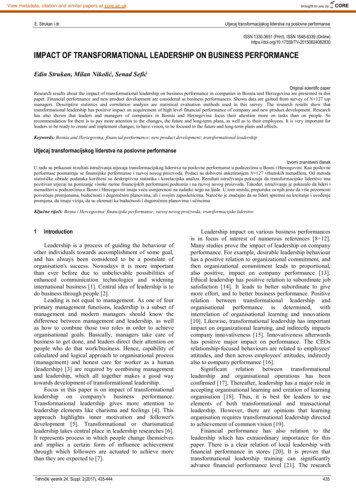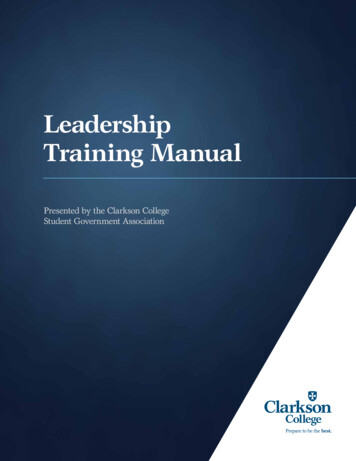
Transcription
Leadership Development Program (LDP) HandbookLEADERSHIP DEVELOPMENT PROGRAM (LDP) HANDBOOK12 July 2002TABLE OF CONTENTSSUBJECT1. REFERENCESPAGE12. PURPOSE13. GENERAL14. LEADERSHIP DEVELOPMENT PROGRAM (LDP)1a.b.c.d.PurposeTraining for the FutureFeatures of LDPLDP Model12245. ASSESSING BEHAVIOR5a. Recognizing Behaviorb. Recording Behaviorc. Classifying ng ActionsOperating ActionsImproving Actionsd. Rating Behaviore. Leadership Assessment/Spot ReportSample Leadership Assessment ReportSample Spot Reportf. Cadet Self AssessmentSample Cadet Self Assessment Reportg. Performance Feedback-AAR-Developmental Counseling6. JOB PERFORMANCE SUMMARY CARDa. Generalb. JPSC AdministrationCadet-Focused JPSCAssessor-Focused JPSC68101112121313141518202223242525273031313134
Leadership Development Program (LDP) HandbookSUBJECTAppendix A - LEADERSHIP PERFORMANCE INDICATORSPAGEA-1Appendix B - LDP FORMSB-1Appendix C - CADET EVALUATION REPORTC-1Appendix E - AFTER-ACTION REVIEWE-1Appendix F - SAMPLE OF RECORDED BEHAVIORF-1Appendix G - ADMINISTERING THE LDP PROGRAMG-1INDEX OF FIGURESFigure 1LDP Model4Figure 2Cycle of Assessment6Figure 3Leadership Areas and Dimensions10Figure 4Recording Initial Ratings17Figure 5Sample Leadership Assessment Report (Front)20Figure 6Sample Leadership Assessment Report (Reverse)21Figure 7Sample Spot Report (Front)22Figure 8Sample Spot Report (Reverse)23Figure 9Sample Cadet Self-Assessment Report (Front)24Figure 10 Sample Cadet Self-Assessment Report (Reverse)25Figure 11 Sample Job Performance Summary Card (Cadet Focused)33
Leadership Development Program (LDP) Handbook1. REFERENCES:a. AR 145-1, Senior Reserve Officers’ Training Corps Program: Organization, Administration, andTrainingb. Cadet Command Regulation 145-3, Pre-commissioning Training And Leadership Developmentc. FM 22-100, Army Leadership2. PURPOSE: To establish procedural guidance for the execution of the Leadership DevelopmentProgram within Cadet Command3. GENERAL : Leader development is a continuous process of training, assessment and feedback withthe goal of instilling and enhancing desirable behavior in military organizational managers. Within CadetCommand, this process is known as the Leadership Development Program (LDP), modeled afterprinciples spelled out in FM 22-100, Army Leadership, and standardized in campus and campenvironments. The flexible methodology of LDP accommodates personalized, individual development atall levels of proficiency throughout the cadet’s ROTC experience, from program entry to commissioning.The LDP includes basic leadership training, periodic assessment, and counseling at both team andindividual levels by experienced observers. Trends and corrective actions are identified and followedwith retraining and reassessment in a continuous cycle. Effective leader development is progressive,building on lessons learned and maximizing individual potential.4. LEADERSHIP DEVELOPMENT PROGRAM (LDP).a. Purpose. The LDP is an individual-focused training process designed to develop leadership skillsin a variety of training environments. Periodically, cadet progress is determined and individual potentialto lead soldiers summarized. The integrated system of structured leadership opportunities is designed tomaximize potential and predict success as a 2LT. The LDP seeks to develop cadets into officers who:(1) BE:-Live by the Army Values-Have specific mental, physical, and emotional Attributes(2) KNOW:-Demonstrate specific conceptual, interpersonal, technical, and tactical SkillsPage 1
Leadership Development Program (LDP) Handbook(3) DO: Act to-Influence others through communication, decisiveness, and motivation-Operate units by planning, executing, and assessing progress-Improve the Army by developing people, teams, and selfb. Training for the Future: Cadets train to meet the need of the Army for leaders of character whocan take charge under any condition. Properly administered, leader development provides cadets withsystematic problem solving and self-analysis skills in a progressive cycle of training, periodicassessment, constructive counseling, retraining and reassessment. The counseling and other feedbackprocesses mirror those used in the US Army, familiarizing cadets with the expectations of the leader andenhancing their self-sufficiency and ability to lead soldiers effectively in a wide variety of situations.Additionally, analysis of each cadet’s growth or failure to grow provides valuable insight to the cadet’sleadership potential. While time constraints do not normally allow cadets to be trained to full potentialduring their time in the program, the skills they receive while there allow continued development longafter they leave ROTC.c. Features of LDP: The assessment process within LDP is standardized throughout the commandand is based on the following features:(1) Standardized Assessment Technology. Each camp and campus program assesses cadetbehavior using a prescribed process and common leadership dimensions/performance standards(Appendix A). Each assessor must be trained in the LDP and its applications and faithfully model LDPskills and standards whenever possible. Standardized Cadet Command reports (Appendices B, C, & D)are used to document performance and potential.(2) Individual Focus. The LDP establishes a model that identifies individual training needs,creates a plan of development, trains, and assesses cadet performance, all with the goal of developingcadets to their maximum individual potential. Following each assessment, cadets are provided timely,focused developmental feedback in the form of individual counseling. Cadet performance is thoroughlydocumented in individual cadet files (e.g., Job Performance Summary Cards and the Cadet EvaluationReport) that reflect information used to quantify performance and potential. The assessment of individualgrowth considers each cadet’s history of performance.(3) Provides Developmental Feedback. Timely periodic performance feedback provides cadetswith tools to begin improvement. Each time cadet performance is assessed, notable strengths andPage 2
Leadership Development Program (LDP) Handbookweaknesses are addressed and specific means for improvement are discussed with the cadet in detail.Depending on the nature of the assessment scenario, the assessor provides formal or informal feedback.Common methods of feedback include performance test scores, counseling sessions, coaching,encouraging and individual or team after action reviews (AARs).(4) Structuring Leadership Opportunities. Leadership opportunities are practical exercises inleading and caring of subordinates, and are used as a training tool to emphasize key teaching points.Given sufficient time, cadets exhibiting random behavior will eventually demonstrate their abilities andpotential. Due to its unpredictability, random behavior cannot be relied upon as a means of illustratingand emphasize teaching points in a timely manner. The LDP utilizes formally structured leadershipopportunities, where cadets are assigned leadership duties with specific and implied tasks, given time toplan and prepare, and allowed to execute the assigned duties in a leadership role. The use of structuredopportunities enables assessors to direct variables necessary to ensure that cadets experiencesituations that meet developmental needs.(5) Assessor Qualification. While unique to Cadet Command, the LDP derives its basicelements from Army leadership principles. Battalion cadre bring to ROTC a familiarity with thoseprinciples, along with a variety of technical, tactical, and leadership experiences. However, the greateremphasis placed on leader development in Cadet Command demands degrees of proficiency andstandardization among assessors beyond those required in most Army experiences. Initial leadershipassessor training from the School of Cadet Command and subsequent on-the-job training (OJT) directedby battalion commanders complements previous experience. Camp evaluation staffs provideappropriate orientation and assessment training to cadre assigned as TAC Officers/Non-CommissionedOfficers. Camp training committee evaluators are also trained in the assessment process, emphasizingspecific responsibilities for their particular committees, but based on standardized LDP assessmentpolicies and principles.(6) Peer Ratings. Peer assessments utilize the viewpoint of other cadets to provide additionaldevelopmental feedback to cadet leaders. Battalion commanders and camp cadre employ peerasses sments to assist in validating cadre assessments, identify trends and issues from within the cadetteam, and provide valuable perspective on leader performance by those most affected. Because of theircloser physical and social proximity, peers are often the first to identify issues affecting leaderperformance.(7) Link to Evaluation and Accessions. Cadet performance at camps and on campus is linkedto evaluation and cadet management decisions (e.g., contracting, cadet promotions, overall campPage 3
Leadership Development Program (LDP) Handbookperformance, commissioning). In addition, the complete record of cadet performance/potential oncampus and at camp is fully documented on the Cadet Evaluation Reports and entered into the cadet’saccessions packet.d. LDP MODEL: Leader Development begins on the cadet’s entry into the ROTC program andcontinues until the cadet is commissioned as a lieutenant. The focus shifts over time from basic life skills(interpersonal behavior, time management, physical appearance, etc.) to more complex, professionallevel skills equal to those expected of a lieutenant. Figure 1 reflects the command model foradministering the LDP.MS I & IICounseling1st SemesterBlueCardCampusCounseling(DA Form 4856)2d Semester YellowCard JPSCCERAccessionsPacketMS IIICampMS IVBlueCard YellowCard67-9-167-9-1A JPSC ScoredEventsOERDevelopment PlanFigure 1LDP ModelPage 4CER
Leadership Development Program (LDP) Handbook(1) MS I and MS II Years. The PMS ensures all MS I and MS II cadets each semester receivedevelopmental counseling from either an upper class cadet or a member of the battalion cadre. Whilethe PMS may adjust this scheme to fit school circumstances, battalion cadre control the quality of allcounseling, both in form and content. This counseling is recorded on DA Form 4856, DevelopmentalCounseling Form (Appendix. B).(2) MS III Year. From the standpoint of training, assessment, and leadership development, theMS III year is the most intensive of a cadet’s ROTC experience. It is in this year, as the cadet preparesfor and attends the National Advanced Leadership Camp (NALC), that performance and potential databecomes a part of the permanent evaluation and cadet accessions record. In both instances the cadetserves in a series of leadership positions where performance is assessed by cadre, cadet selfassessment, and trends in behavior evaluated over time. The PMS maintains a record of cadetperformance during the MS III or MS IV year (whichever immediately precedes camp attendance) andthis data reflected on the Cadet Evaluation Report (CER). Likewise, at NALC, the JPSC and all scoredevents data is used by the Platoon TAC in developing the CER for each cadet in the platoon. FollowingNALC, battalion cadre use feedback obtained to determine developmental requirements for the MSIVyear.(3) MS IV Year. As they prepare for entry into Army service, MS IV cadets, with help frombattalion cadre, prepare an Officer Development Support Form and a Junior Officer DevelopmentSupport Form, IAW AR 623-105. The PMS counsels cadets based on their performance and supportforms and completes an Officer Evaluation Report for each MS IV cadet during the last semester of theMS IV year.(4) LDP Reports and Forms. To facilitate the LDP process, Cadet Command has adoptedstandardized administrative formats used for recording and reporting cadre observations. Theadministrative forms are shown in Appendix B, LDP Forms, and Appendix C, Cadet Evaluation Report.The use of these forms is directed and standardized in all Cadet Command training IAW this publication.5. ASSESSING BEHAVIOR: Assessment is a periodic process that follows previous training andmeasures its effectiveness. Using information gathered through assessment, leader progress is gauged,proficiency determined, and developmental plan validated. Periodic assessment is a critical componentof a cycle of continuous, progressive training (Figure 2) that identifies developmental needs and providesnecessary corrective actions.Page 5
Leadership Development Program (LDP) HandbookCycle of AssessmentFigure 2a. RECOGNIZING BEHAVIOR: Defined as the response of an individual to its environment,behavior is constantly present to one degree or another. Leader behavior is that which impacts currentand future leader effectiveness. Assessors must be proficient in distinguishing between behavior thataffects leader effectiveness and that which carries little, if any, impact.(1) Critical and Non-Critical Behavior: For the purposes of development, behavior canconveniently be divided into two categories; critical, (leader) behavior, and non-critical behavior. Criticalbehavior has significant impact on the effectiveness of the leader in current or future situations; noncritical behavior has little or no impact. Since the criticality of behavior often changes with theenvironment, behavior must always be viewed in the context of the current situation. In unstructuredobservations of leader performance, an abundance of non-critical behavior may provide little insight tothe individual’s leader effectiveness; in order to gain critical information, the observation period may beunacceptably extended. In order to maximize training value, individuals are often placed in structuredleadership opportunities which are designed to elicit certain critical behaviors within a reasonable periodof time.(2) Direct and Indirect Observation: Behavior may be directly or indirectly observed. Manyaspects of individual physical behavior (e.g., appearance, interaction, outward displays of emotion, etc.)are directly observable. While mental processes are not directly observable, they are often evident in theindividual’s behavior and may be accurately, albeit indirectly, observed (e.g., individual’s response to acrisis gives insight to the decision-making process).Page 6
Leadership Development Program (LDP) Handbook(3) First- and Second-Hand Observation: Behavior may be recognized through first-hand orsecond-hand observation. First-hand observation is the personal observation of behavior by theassessor. Second-hand observations are those gained through review of results (e.g., even if the ordersprocess was not observed, the assessor may determine leader effectiveness by querying subordinates toensure critical information has been disseminated) or through information provided by other assessors.When relying on second-hand observations, assessors must judge the accuracy of the source beforecoming to a conclusion.(4) Expanding the Scope of Observation: Leaders are expected to exhibit character whether ina traditional position of leadership (squad leader, platoon sergeant, etc) or not. Cadets who areassessed only during leadership opportunities may sense that leadership is important only when anassessment is taking place. Using the predictability of recurring leadership opportunities to theiradvantage, some cadets use gamesmanship and performance “masking” to inappropriately anticipateproblems and hide personal shortcomings, and revert to their true character once the leadershipopportunity is over. By observing the cadet under a variety of unfamiliar situations, where problemsolving skills are challenged and where character is often displayed in candid, unguarded moments ofspontaneous behavior, development is maximized. Such spontaneity can be initiated by moving thecadet out of the comfort zone of familiar surroundings, both in and out of the ROTC environment.Additionally, a great deal can be learned about a cadet’s true character by judicious attention to day-today behavior and outside sources such as peers, academic advisors, law enforcement agencies, family,friends, etc. Particular attention should be paid to the slightest indications of:A. Alcohol or substance abuse – marked, unexplained changes in behavior or performance(both positive and negative), public drunkenness, drinking while alone or throughout the day, etc.B. Time management problems – inability to meet demands of academics or workschedule.C. Personality or psychological problems – inappropriate, antisocial or irrational behavior,lapses in judgment or immaturity.D. Academic difficulties – inability to grasp and apply concepts, signs of learning disabilitiesE. Family problems – inappropriate handling of domestic issues, spouse or child abuse, orsimilar issues with boy-or girlfriendPage 7
Leadership Development Program (LDP) HandbookF. Financial difficulty – recurring or habitual indebtedness, living beyond resources, inabilityto live within budgetG. Dishonesty – habitual lying, failure to accept responsibility, stealing, tolerating or coveringup others’ actsH. Lack of social skills – chronic immaturity, aggressive or combative, excessive shyness,inappropriate language, generally obnoxious, avoids contact with others, intolerant of peers, refusal tosocialize, physically separates from others at functionsJ. Cultural or gender intolerance – racism, bigotry, harassment, inappropriate sexualbehaviorCadre should consider information from any source after investigating to ensure credibility. Undesirablebehavior in any one of these areas can negatively impact a leader’s effectiveness in the future.Identifying trends and applying timely corrective actions may stop incipient problems before they becomelife-long habits. Additionally, attention to behavior that falls outside the traditional military environmentreinforces the perception that leaders are expected to maintain character at all times, not only whenparticipating in military training.b. RECORDING BEHAVIOR: In the assessment process, critical details of observed behavior arenoted for future reference (counseling, developmental training, etc.).(1) Noting Behavior - If the time period spanned by the observation is short, the pace less rapid,or the behavior less complex, details are often noted mentally; if the time period is longer, pace morerapid, or behavior more complex, short term memory may not be trusted to provide necessary detail, andsome form of note-taking is useful.(2) Written Notes - Written notes should contain sufficient information to enable the assessor torecall salient details. The detail contained in notes is dependent on the experience and proficiency of theassessor; experienced assessors may streamline the note-taking process by using appropriateabbreviations.(3) Notes as an Aid - As levels of proficiency vary from assessor to assessor, so does thedegree of detail needed in recording behavior. As proficiency increases, notes tend to become moreconcise and focused. The assessor must accurately reflect the context and nature of the behavior whenPage 8
Leadership Development Program (LDP) Handbookrecording behavior for use by a third party (cadre with an interest in the leader’s performance but notpresent at the observation, e.g., PMS).(4) Note-taking tips:A. Notes are tools used to recreate the context surrounding critical behavior and increase thequality of performance feedback. Although not a part of the formal administrative record, assessors oftenfind a need to refer to specific behavior that has taken place in the past. To facilitate quick reference,assessors should maintain an organized record of notes taken.B. Allow events to develop before recording. By doing so, the assessor gains a morecomplete picture of behavior and reduces unproductive note-taking. Observe behavior for a reasonableperiod of time, ranging from several minutes to several hours, depending on the task. At the conclusionof the time period, at a logical point or break in action, summarize what was seen in its full context.C. To reduce the inefficiency of non-productive writing, the assessor must differentiatebetween critical (relevant) and non-critical (irrelevant) behavior. It is seldom necessary to record allactions taken by an individual.D. Some dimensional behavior (e.g., Interpersonal, Communication, Physical, etc.) mightreasonably be expected to recur and be seen frequently throughout the leadership opportunity.Assessors should refrain from recording each incident of commonly recurring behavior; instead,summarize that behavior at the conclusion of the opportunity. Summarized statements should recognizespecific examples of behavior that are exceptionally positive or negative and that may be used to supportsummary ratings as well as behavior to be noted in performance counseling.E. Ensure abbreviations or “shorthand” used to reduce writing is easily understood.F. Note-taking is a counseling aid, allowing assessors to accurately reference specificexamples of behavior to support summary ratings and illustrate performance counseling. Every notetaken should have a purpose.c. CLASSIFYING BEHAVIOR: Classifying behavior aids in focusing developmental attention onbehavioral causes rather than results. Leader behavior is classified by breaking it down into its mostbasic elements, first by Area, then by Dimension. In FM 22-100, the critical elements of leader behaviorare generally categorized into 6 leadership areas: Values, Attributes, Skills, and the Influencing,Page 9
Leadership Development Program (LDP) HandbookOperating and Improving Actions. Each area highlights separate and distinct aspects of behavior thatimpact leader effectiveness. Within each area, behavior is further broken down into leadershipdimensions. In the LDP model, leadership is comprised of 23 individual dimensions (Figure 3), any (butnot necessarily all) of which may be displayed at any given time. Over time, cadets exhibit some degreeof proficiency (positive or negative) in all dimensions. In the assessment process, behavior in eachobserved dimension is quantified using a proprietary set of standards of performance, or LeadershipPerformance Indicators, and is discussed further in paragraph 5d, Rating Behavior.LEADERSHIP AREAS / DIMENSIONSVALUESLoyaltyDutyRespectSelfless ServiceHonorIntegrityPersonal CINGCommunicatingDecision gAssessingDevelopingBuildingLearningFigure 3Leadership Areas and DimensionsAlthough a short observation of behavior is unlikely to reflect all 23 dimensions, any dimension orcombinations of dimensions may be demonstrated at any given time. With additional opportunities overtime, the trained assessor makes multiple observations of each dimension, enabling an accurateassessment of the individual’s capabilities and limitations. The LDP uses Leadership PerformanceIndicators (Appendix A) to aid in classifying behavior by providing illustrative examples of the types ofbehavior that typically constitute each dimension. Since it is not possible for the examples to be allinclusive, assessors are free to use judgment to classify behavior not specifically referenced in theLeadership Performance Indicators. The following provide encapsulated definitions by Area andDimension to further assist in initial orientation. Where additional guidance is necessary, detaileddefinitions of leadership areas and dimensions are contained in FM 22-100.Page 10
Leadership Development Program (LDP) Handbook(1) Army VALUES (p. 2-1, FM 22-100) – Values reflect the individual’s sense of obligation to andattitudes about other people, concepts, and the profession of arms, and are possessed to varying degreeby all individuals. The goal of leader development is to define and instill Army Values in the individual,reflecting standards of performance exceeding those of society in general. The leader faithfully adheresto Army values in all situations, even to the point of personal sacrifice when necessary. Values are oftenmost visibly demonstrated when personal cost is incurred. As a defender of the Constitution, thecountry, and others not capable of defending themselves, the leader demonstrates commitment throughvalues, and earns the trust of the nation.A. LOYALTY (LO) – Allegiance to those who are reliant on the leader for support. Loyalty isrequired to ensure the success of the chain of command and subordinates, and generates loyalty andsupport in return.B. DUTY (DU) – Fulfilling professional obligations with a strong work ethic; personal initiativecompels the leader to exceed minimum standards. Leaders with a strong sense of duty demonstrate andenforce high professional standards.C. RESPECT (RE) – Treating people as they should be treated. The leader demonstratesthe value of dignity and human worth, creating a positive climate of command and projecting culturaltolerance.D. SELFLESS SERVICE (SS) – Putting the welfare of the nation, the Army, andsubordinates before self. The leader is willing to forego personal comforts for the sake of others, with noprospect of reward.E. HONOR (HO) – Demonstrating a keen sense of ethical conduct; compelled to do the rightthing. The honorable leader protects the reputation of the profession through personal actions.F. INTEGRITY (IT) – Consistently adheres to moral and legal obligations. The leader istruthful and upright at all times.G. PERSONAL COURAGE (PC) – Overcoming personal fears, both physical and psychic.While fears are a necessary component of human behavior, the leader is able to weigh the potentialcosts against the greater need, put fear (both real and imagined) aside and do what is necessary tocomplete the mission.Page 11
Leadership Development Program (LDP) Handbook(2) ATTRIBUTES (p. 2-10, FM 22-100) – Attributes are the physical and mental aspects of theindividual that measure leader effectiveness. Since they often form the basis of the first impression, theleader’s initial effectiveness is particularly affected by Attributes. Unlike Values (which gain credencethrough consistency), the impact of individual Attributes on leader effectiveness may vary from onesituation to the next. The leader is expected to demonstrate appropriate Attributes as the situationdictates and, over time, demonstrate strength in each.A. MENTAL (ME) – Intellectual capacity and stamina; possessing will, self-discipline,initiative, judgment, and self-confidence. The leader demonstrates strength of mind and the ability tomake decisions, even under conditions that strain personal limits.B. PHYSICAL (PH) – Projecting the appearance of strength, health, and ability to excel indemanding situations. The leader conveys a professional image of power through military bearing, evenunder adverse conditions.C. EMOTIONAL (EM) – Demonstrating balance, stability, and self-control; maintaining apositive outlook under duress. The leader maintains control through a sense of calm.(3) SKILLS (p. 4-2, FM 22-100) – Ability to use knowledge effectively in execution orperformance. Skills are acquired and reinforced through training. The leader applies basic skillsappropriate to the situation to accomplish more complex tasks.A. CONCEPTUAL (CN) – Ability to handle ideas, thoughts, and concepts using creativethinking, as well as critical and ethical reasoning in a timely manner. Conceptual skills use both inductiveand deductive reasoning as well as academic and experiential knowledge to assess the proper course ofaction. The leader uses innate intellect (Attribute) to mentally carry out processes to their logical end andpredict outcomes, to weigh various courses of action, create solutions and to make decisions.B. INTERPERSONAL (IP) – Using skill with people to ensure information is completelyconveyed; interpersonal skills demonstrate the ability to gauge the audience, ensure two-waycommunication, and emphasize key points. Leaders use their interpersonal skills to present information,determine whether information was fully understood, supervise tasks in a manner which encouragessubordinates, and provide constructive feedback.Page 12
Leadership Development Program (LDP) HandbookC. TECHNICAL (TE) – Skill with things; equipment, weapons, systems, procedures. Leadersdemonstrate technical skills on an individual level through task accomplishment, and on the collectivelevel in the role of trainer.D. TACTICAL (TA) – Art and science of employing resources to win battles. Tactical skillsemploy the other skills in a coordinated effort in a combat or combat training environment.(4) ACTIONS: Doing the things that need to be done to accomplish the mission. The actions ofthe leader are generally categorized into three areas: Influencing Actions, Operating Actions, andImproving Actions.A. INFLUENCING ACTIONS – Using leadership action to move the team toward current orfuture goals. The manner in which the leader acts results in subordinate reaction, positively ornegatively; the effective leader is aware of this relationship and uses it as a tool to positively impact teamdynamics.1. COMMUNICATING (CO) – Keeping immediate superiors and subordinates informed,ensuring information is complete, accurate, and timely. The effective leader uses communication tools toimprove information flow and ensure the commander’s intent is understood at all levels.2. DECISION MAKING (DM) – Demonstrating conviction and resolve in making toughdecisions; the confidence and resolve displayed by the leader affect the pace at which subordinatesrespond. In fast-paced situations where even momentary hesitation can lose valuable momentum, theeffective leader must be able to make sound judgments (MENTAL) and stand by them in a mannerreflecting commitment (DECIS
Leadership Development Program (LDP) Handbook Page 2 (3) DO: Act to -Influence others through communication, decisiveness, and motivation -Operate units by planning, executing, and assessing progress -Improve the Army by developing people, teams, and self b. Training for the Future: Cadets train










